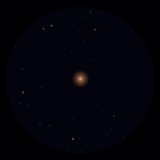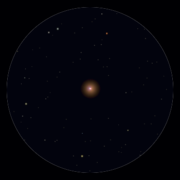
Gamma Andromedae
Encyclopedia

Constellation
In modern astronomy, a constellation is an internationally defined area of the celestial sphere. These areas are grouped around asterisms, patterns formed by prominent stars within apparent proximity to one another on Earth's night sky....
of Andromeda
Andromeda (constellation)
Andromeda is a constellation in the northern sky. It is named after Andromeda, the princess in the Greek legend of Perseus who was chained to a rock to be eaten by the sea monster Cetus...
. It is also known by the traditional name Almach (also spelt as Almaach, Almaack, Almak, Almaak, or Alamak), from the Arabic
Arabic language
Arabic is a name applied to the descendants of the Classical Arabic language of the 6th century AD, used most prominently in the Quran, the Islamic Holy Book...
العناق الأرض al-‘anāq al-’arđ̧ "the caracal
Caracal
The caracal is a fiercely territorial medium-sized cat ranging over Western Asia, South Asia and Africa.The word caracal comes from the Turkish word "karakulak", meaning "black ear". In North India and Pakistan, the caracal is locally known as syahgosh or shyahgosh, which is a Persian term...
" (desert lynx).
Another term for this star used by medieval astronomers writing in Arabic was آلرخل المسلسلة Al Rijl al Musalsalah "the Woman's Foot"
In Chinese
Chinese language
The Chinese language is a language or language family consisting of varieties which are mutually intelligible to varying degrees. Originally the indigenous languages spoken by the Han Chinese in China, it forms one of the branches of Sino-Tibetan family of languages...
, , meaning Heaven's Great General
Bond (Chinese constellation)
Leu sieu meaning "the Train of a garment", was one of the twenty-eight lunar mansions of the traditional Chinese astronomy. It was one of the White Tiger of the West (西方白虎).- The asterisms in the Region of Leu (婁宿天區):...
, refers to an asterism consisting of γ Andromedae, φ Persei
Phi Persei
Phi Persei is a Class B2Vpe, fourth-magnitude star in the constellation Perseus. Due to its isolation and distance from Cassiopeia, Andromeda and the rest of Perseus, John Flamsteed never took thought to assign a number and constellation to Phi Persei.Phi Persei is binary consisting of a blue main...
, 51 Andromedae
51 Andromedae
51 Andromedae is a 4th magnitude star, the 5th brighest in the constellation Andromeda. It does not have a Bayer designation. It is occasionally called by the proper name Nembus in Bayer's Uranometria and Bode's star atlas Uranographia .Ptolemy included this star in Andromeda in the Almagest, but...
, 49 Andromedae
49 Andromedae
49 Andromedae is a star in the constellation Andromeda. Its apparent magnitude is 5.27....
, χ Andromedae
Chi Andromedae
Chi Andromedae is a star in the constellation Andromeda. It with φ And composed Chinese asterism 軍南門 , "the South Gate of the Camp"....
, θ Andromedae
Upsilon Andromedae
Upsilon Andromedae is a binary star located approximately 44 light-years away from Earth in the constellation Andromeda. The primary star is a yellow-white dwarf star that is somewhat younger than the Sun...
, τ Andromedae
Tau Andromedae
Tau Andromedae is a star in the constellation Andromeda. It is approximately 681 light years from Earth. This is a blue-white B-type giant with an apparent magnitude of +4.96.-References:*...
, 56 Andromedae
56 Andromedae
56 Andromedae is a binary star in the constellation Andromeda. Its apparent magnitude is 5.69. This binary system is composed of two yellow giants and is located near the open cluster NGC 752.-References:*...
, β Trianguli
Beta Trianguli
Beta Trianguli is the brightest star in the constellation Triangulum.In Chinese traditional astronomy, it was the 9th star of Tien Ta Tseang ....
, γ Trianguli
Gamma Trianguli
Gamma Trianguli is a star in the constellation Triangulum.Gamma Trianguli is a white A-type main sequence dwarf with an apparent magnitude of +4.03. It is approximately 118 light years from Earth....
and δ Trianguli
Delta Trianguli
Delta Trianguli is a spectroscopic binary star system approximately away in the constellation of Triangulum. The primary star is a yellow dwarf, while the secondary star is thought to be an orange dwarf...
. Consequently, γ Andromedae itself is known as
In the catalogue of stars in the Calendarium of Al Achsasi al Mouakket
Al Achsasi al Mouakket
Mohammad Al Achsasi Al Mouakket was an Egyptian astronomer whose calendarium and catalogue of stars, entitled Durret al Muddiah Fih al Aamal al Shamsiah , was written at Cairo about 1650.Al Achsasi was sheikh of the Grand Mosque of the University of Cairo, where his name al...
, this star was designated جمس ألنعامة Khamis al Naamat, which was translated into Latin
Latin
Latin is an Italic language originally spoken in Latium and Ancient Rome. It, along with most European languages, is a descendant of the ancient Proto-Indo-European language. Although it is considered a dead language, a number of scholars and members of the Christian clergy speak it fluently, and...
as Quinta Struthionum, meaning the fifth ostrich.
In 1778, Johann Tobias Mayer
Johann Tobias Mayer
Johann Tobias Mayer was a German physicist. He was mainly well known for his mathematics and natural science textbooks. Anfangsgründe der Naturlehre zum Behuf der Vorlesungen über die Experimental-Physik, an 1801 physics text, was the most influential of its time in the German-speaking countries...
discovered that γ Andromedae was a double star
Double star
In observational astronomy, a double star is a pair of stars that appear close to each other in the sky as seen from Earth when viewed through an optical telescope. This can happen either because the pair forms a binary star, i.e...
. When examined in a small telescope
Telescope
A telescope is an instrument that aids in the observation of remote objects by collecting electromagnetic radiation . The first known practical telescopes were invented in the Netherlands at the beginning of the 1600s , using glass lenses...
, it appears to be a bright, golden yellow star (γ1 Andromedae) next to a dimmer, indigo blue star (γ2 Andromedae), separated by approximately 10 arcseconds. It is considered by stargazers to be a beautiful double star with a striking contrast of color. It was later discovered that γ2 Andromedae is itself a triple star system
Star system
A star system or stellar system is a small number of stars which orbit each other, bound by gravitational attraction. A large number of stars bound by gravitation is generally called a star cluster or galaxy, although, broadly speaking, they are also star systems.-Binary star systems:A stellar...
. What appears as a single star to the naked eye is thus a quadruple star system, approximately 350 light-years from the Earth.
In the Babylonian star catalogues
Babylonian star catalogues
Babylonian astronomy collated earlier observations and divinations into sets of Babylonian star catalogues, during and after the Kassite rule over Babylonia. These star catalogues, written in cuneiform script, contained lists of constellations, individual stars, and planets...
, γ And together with Triangulum
Triangulum
Triangulum is a small constellation in the northern sky. Its name is Latin for triangle, and it should not be confused with Triangulum Australe in the southern sky. Its name derives from its three brightest stars, of third and fourth magnitude, which form a nearly isosceles long and narrow triangle...
formed the constellation known as MULAPIN "The Plough".
Astrologically this star was considered "honourable and eminent."
γ1 Andromedae
γ1 Andromedae is a bright giantBright giant
The luminosity class II in the Yerkes spectral classification is given to bright giants. These are stars which straddle the boundary between giants and supergiants, and the classification is in general given to giant stars with exceptionally high luminosity, but which are not sufficiently bright...
star
Star
A star is a massive, luminous sphere of plasma held together by gravity. At the end of its lifetime, a star can also contain a proportion of degenerate matter. The nearest star to Earth is the Sun, which is the source of most of the energy on Earth...
with a spectral classification of K3IIb. It has an apparent visual magnitude of approximately 2.26.
γ2 Andromedae
γ2 Andromedae, with an overall apparent visual magnitude of 4.84, is 9.6 arcsecondsMinute of arc
A minute of arc, arcminute, or minute of angle , is a unit of angular measurement equal to one sixtieth of one degree. In turn, a second of arc or arcsecond is one sixtieth of one minute of arc....
away from γ1 Andromedae at a position angle
Position angle
Position angle, usually abbreviated PA, is a measurement derived from observing visual binary stars. It is defined as the angular offset in degrees of the secondary star to the primary, relative to the north celestial pole....
of 63 degrees. In October 1842, Wilhelm Struve found that γ2 Andromedae was itself a double star whose components were separated by less than an arcsecond. The components are an object of apparent visual magnitude 5.5, γ Andromedae B, and a type-A main sequence star with apparent visual magnitude 6.3, γ Andromedae C. They have an orbital period of about 64 years. Spectrograms taken from 1957 to 1959 revealed that γ Andromedae B was itself a spectroscopic binary, composed of two type-B main sequence stars orbiting each other with a period of 2.67 days.
Location
The star's location is shown in the following chart of the Andromeda constellation:See also
- Gamma Andromedae in fiction
- NGC 752NGC 752NGC 752 is an open cluster in the constellation Andromeda. The cluster was discovered by Caroline Herschel in 1783 and cataloged by her brother William Herschel in 1786, although an object that may have been NGC 752 was described by Giovanni Batista Hodierna before 1654.The large cluster lies...
External links
- Almaak (Gamma Andromedae) at The Internet Encyclopedia of Science
- Image ALMACH

